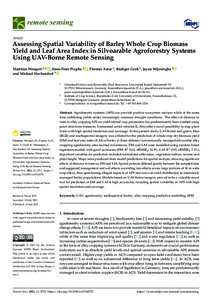| dc.date.accessioned | 2021-07-23T09:07:59Z | |
| dc.date.available | 2021-07-23T09:07:59Z | |
| dc.date.issued | 2021-07-13 | |
| dc.identifier | doi:10.17170/kobra-202107234399 | |
| dc.identifier.uri | http://hdl.handle.net/123456789/13033 | |
| dc.description.sponsorship | Gefördert durch den Publikationsfonds der Universität Kassel | ger |
| dc.language.iso | eng | |
| dc.rights | Namensnennung 4.0 International | * |
| dc.rights.uri | http://creativecommons.org/licenses/by/4.0/ | * |
| dc.subject | UAV | eng |
| dc.subject | agroforestry | eng |
| dc.subject | multispectral | eng |
| dc.subject | barley | eng |
| dc.subject | alley cropping | eng |
| dc.subject | predictive modellingeng | eng |
| dc.subject | SFM | eng |
| dc.subject.ddc | 630 | |
| dc.title | Assessing spatial variability of barley whole crop biomass yield and leaf area index in silvoarable agroforestry systems using UAV-borne remote sensing | eng |
| dc.type | Aufsatz | |
| dcterms.abstract | Agroforestry systems (AFS) can provide positive ecosystem services while at the same time stabilizing yields under increasingly common drought conditions. The effect of distance to trees in alley cropping AFS on yield-related crop parameters has predominantly been studied using point data from transects. Unmanned aerial vehicles (UAVs) offer a novel possibility to map plant traits with high spatial resolution and coverage. In the present study, UAV-borne red, green, blue (RGB) and multispectral imagery was utilized for the prediction of whole crop dry biomass yield (DM) and leaf area index (LAI) of barley at three different conventionally managed silvoarable alley cropping agroforestry sites located in Germany. DM and LAI were modelled using random forest regression models with good accuracies (DM: R² 0.62, nRMSEp 14.9%, LAI: R² 0.92, nRMSEp 7.1%). Important variables for prediction included normalized reflectance, vegetation indices, texture and plant height. Maps were produced from model predictions for spatial analysis, showing significant effects of distance to trees on DM and LAI. Spatial patterns differed greatly between the sampled sites and suggested management and soil effects overriding tree effects across large portions of 96 m wide crop alleys, thus questioning alleged impacts of AFS tree rows on yield distribution in intensively managed barley populations. Models based on UAV-borne imagery proved to be a valuable novel tool for prediction of DM and LAI at high accuracies, revealing spatial variability in AFS with high spatial resolution and coverage. | eng |
| dcterms.accessRights | open access | |
| dcterms.creator | Wengert, Matthias | |
| dcterms.creator | Piepho, Hans-Peter | |
| dcterms.creator | Astor, Thomas | |
| dcterms.creator | Graß, Rüdiger | |
| dcterms.creator | Wijesingha, Jayan | |
| dcterms.creator | Wachendorf, Michael | |
| dc.relation.doi | doi:10.3390/rs13142751 | |
| dc.subject.swd | Präzisionslandwirtschaft | ger |
| dc.subject.swd | Agroforstwirtschaft | ger |
| dc.subject.swd | Flugkörper | ger |
| dc.subject.swd | Gerste | ger |
| dc.subject.swd | Ernte | ger |
| dc.type.version | publishedVersion | |
| dcterms.source.identifier | eissn:2072-4292 | |
| dcterms.source.issue | Issue 14 | |
| dcterms.source.journal | Remote sensing | eng |
| dcterms.source.volume | Volume 13 | |
| kup.iskup | false | |
| dcterms.source.articlenumber | 2751 | |


